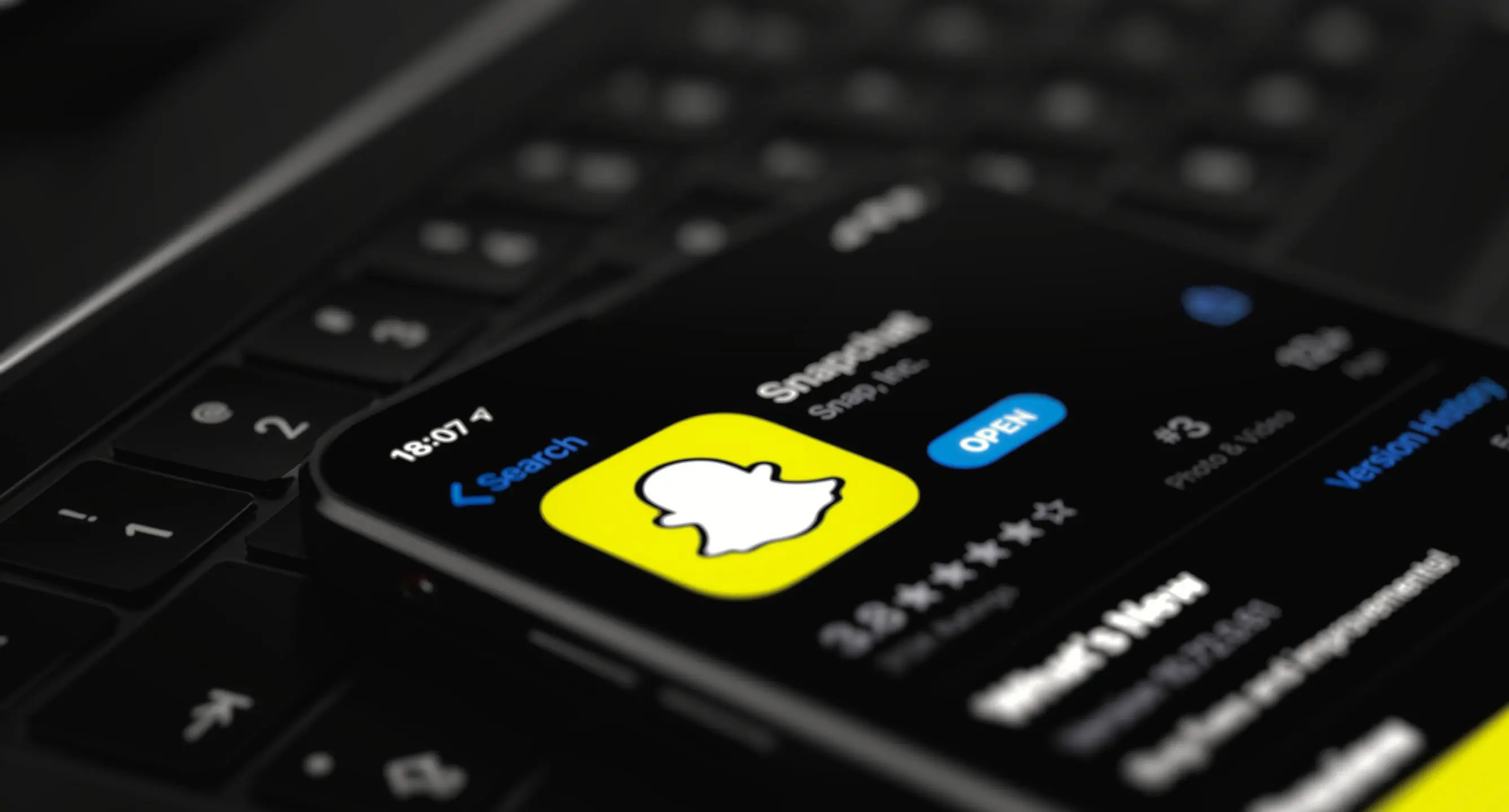Join the Movement - Sign the Delay Manifesto 📑
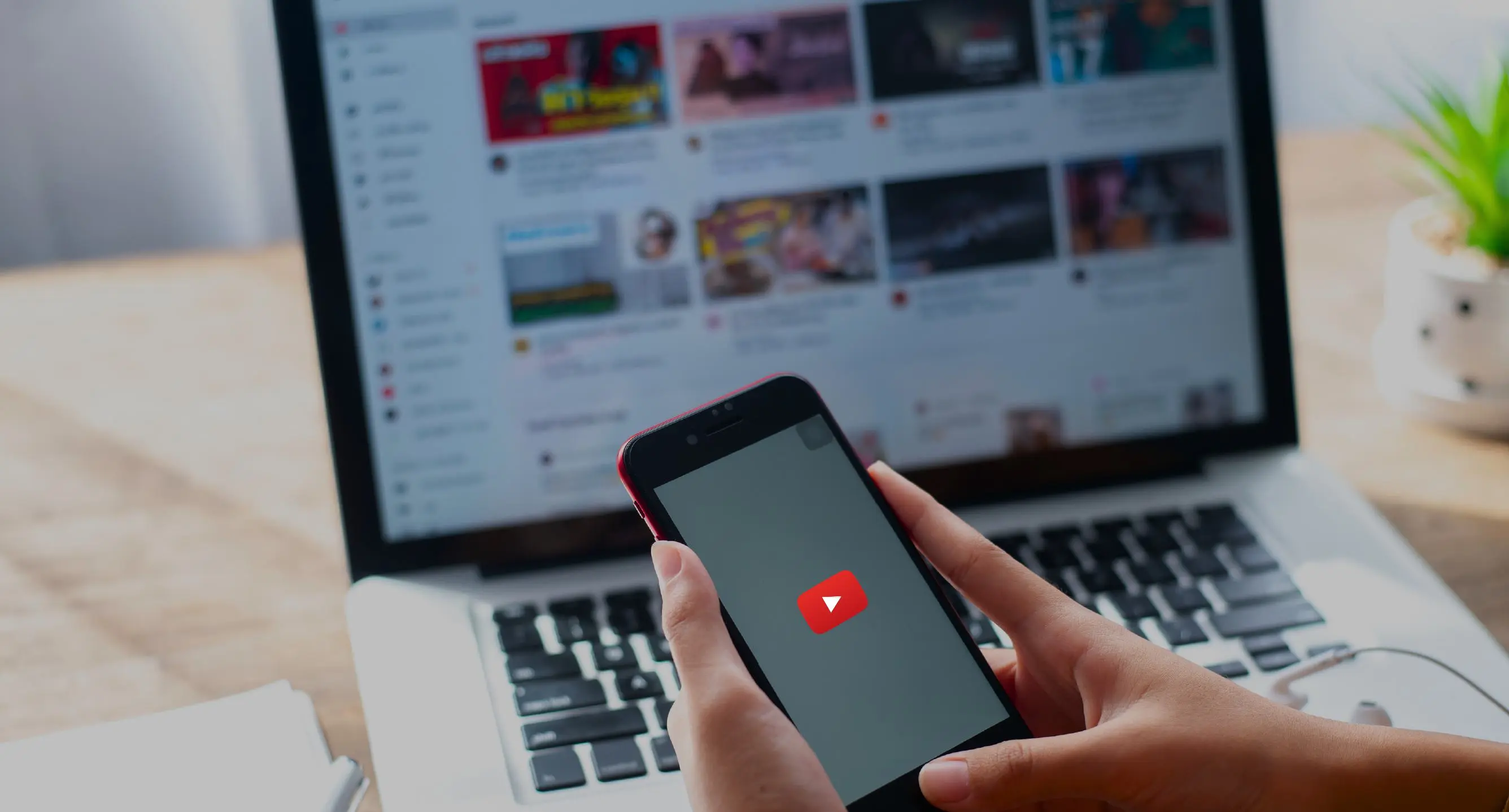

The Ultimate Guide to YouTube for Caregivers
So, Is YouTube Safe for Kids?
That’s a complicated question. But it’s one that rolls around in the minds of most parents!
Everyone watches YouTube, especially teens! A 2023 Pew Research study found that 95% of teens ages 13-17 use YouTube – TikTok was second with 67%! Which means we get lots of questions about the platform. Rightfully so.
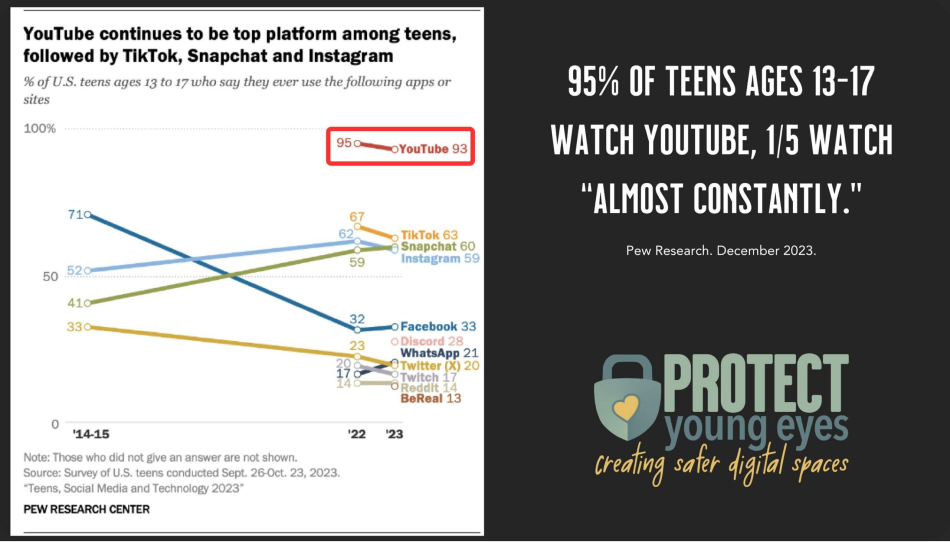
YouTube is full of educational videos, exciting movie trailers, Minecraft “let’s play,” reviews, vlogs, guides, funny memes, tutorials, fail montages, and beloved cat videos. We love this and many kids enjoy good entertainment on YouTube.
But…
Horror stories of kids being exposed to videos that teach them to hurt themselves, terrifying characters or animations that cause nightmares and sleeping problems, grooming and scamming through comments, harassment, and cyberbullying, vulgar and explicit language, inappropriate content with links to pornographic websites, animal torture, executions, mass shootings, you name it – it’s been on YouTube.
So, naturally, these are the questions we receive:
- PYE, is there a way to make it safer?
- Should my kid have their own YouTube Channel?
- Can I check what they’re watching?
- Is there any way to filter YouTube content?
The answer to many of these questions is, “Yes! But here’s the problem…” and we explain it all below.
What is YouTube?
YouTube is the world’s largest video-sharing platform with over 2 billion monthly users. It is the second largest search engine, following Google, which owns YouTube. Everything and everyone is on YouTube. For better or worse.
While it’s rated 13+ in the Apple App Store (Teen in Google Play, and was 17+ in Apple until December 2022), YouTube is not a place where elementary and middle school children should be allowed to wander unattended.
YouTube Kids, is made for younger audiences (usually under age 9). It’s typically safer but isn’t foolproof. Some of the horror stories listed above were found exclusively on YouTube Kids. If you have an elementary school child, please see our YouTube Kids App Review and discern which app best suits your family.
YouTube Terminology:
YouTube uses a lot of different, confusing terms to describe its filters, features, and settings. We want to clarify.
Restricted Mode:
- Refers to the most common content filter on YouTube.
- A fairly effective filter that hides the most mature content.
- Disables the Comment Section and Incognito Mode (which is great).
- It’s the default filter setting when YouTube is used without being logged in (which is also good).
Supervised Account:
- Refers to a Google account set up for a child.
- There are three different filter levels for supervised accounts: Explore (age 9+), Explore More (13+), and Most of YouTube.
Family Link:
- The brand name for all of Google’s parental controls. The logo is a kite.
- Offers advanced settings for you to manage your child’s Google account.
- Access to settings that prevent your child from making changes to their account.
Using these together helps make YouTube much safer for your child. But it gets confusing! So, we tested all of these settings to help clarify how all of this works on the practical level.
How do YouTube’s Settings work?
We did some testing on YouTube by using different combinations of settings to learn more about how Supervised Accounts and Restricted Mode impact content that a kid could look for on YouTube.
Here’s our YouTube Safety Scale that displays how Supervised Accounts and Restricted Mode work, and what your kid might be able to find:

To summarize:
- Using a Supervised Account set to the Explore content level (9+) provided the safest experience on YouTube.
- Using a Parent Account or any adult’s account without Restricted Mode provided the least safe experience on YouTube.
Phew! That was a good chunk of YouTube knowledge. Take a deep breath, you’re doing great!
Next, we’ll go step by step and show you how to understand and navigate YouTube, make YouTube safer for specific devices, walkthrough account creation, and finally, we’ll go over the most common YouTube-related questions we receive from parents.
Let’s get started with some general information about this powerful app!
What are the Main Sections of YouTube?
We want to explain four options in the main YouTube menu:
- Home – what you see when you open the app.
- YouTube Shorts – their 60-second “short” videos to compete with TikTok. Becoming more and more popular (and YouTube is pushing them more).
- Subscriptions – creator accounts.
- Library – where search and watch history is kept.
Important to note that these tabs are in slightly different places based on the device you use.
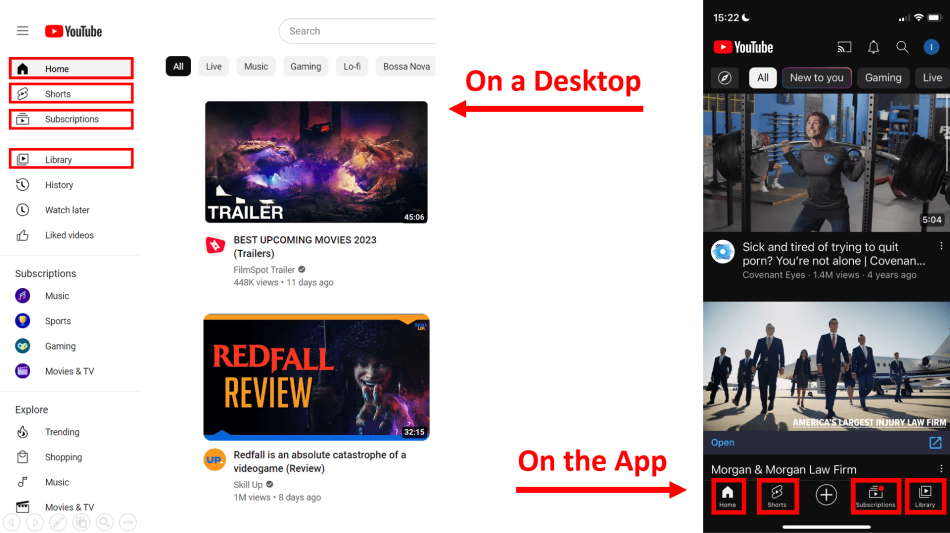
Home: What have I been Watching?
Your Home page is the hub of getting around and being introduced to content and creators.
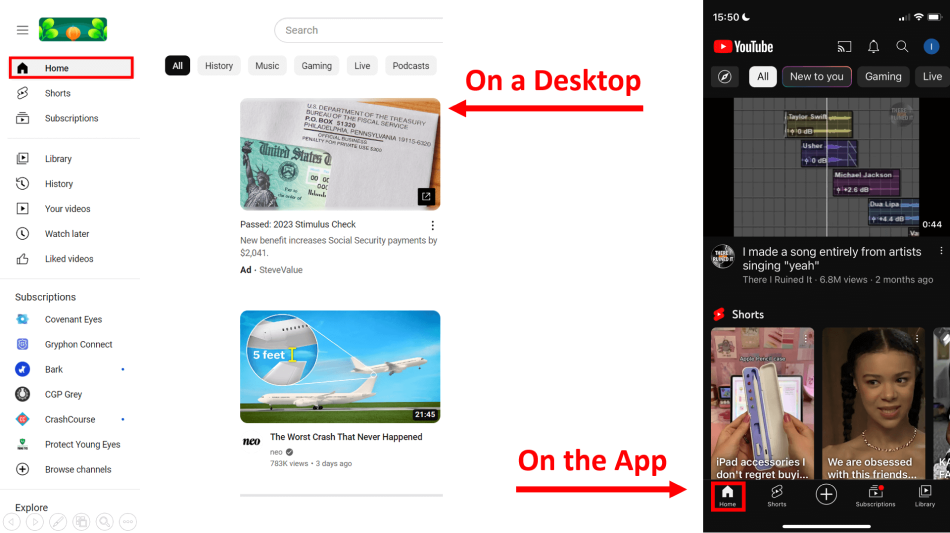
If you’re logged into YouTube, whether on a desktop, Chromebook, or the YouTube app, the algorithm recommends videos based on what you have watched, topics you’ve “liked,” as well as what’s currently trending.
Your Home page is often revealing to what you watch, and search, and the kinds of accounts and videos you interact with. However, this isn’t 100% reflective of what you’ve watched. Weird things pop up, all the time.
This means the YouTube algorithm can be a great conversation starter with your kids:
- YouTube tip #1 – ensure kids 10+ always use YouTube minimally in Restricted Mode.
- YouTube tip #2 – sit down and watch YouTube with your child from time to time! This is the “co-play” part of the PYE Digital Trust Framework. We want kids to know that they’ve got nothing to hide because you’re lovingly involved.
- YouTube tip #3 – assuming your child is logged in (don’t worry, we explain how to create a child account below), maybe review the videos shown on their homepage from time to time and use this to start a conversation. Remember, the algorithm might know things about your kid that can help you know what they like! A YouTube watch history is a wonderful window into the heart of your child.
What are YouTube Shorts?
This is a newer feature that allows users to create, watch, and share fast-paced TikTok-styled videos, all no longer than 60 seconds. You can access Shorts in the left menu on a desktop, or in the bottom options in the YouTube app.
- YouTube tip #4: scroll through and watch about 10-15 shorts on your kid’s account. If you see anything weird, tap the three dots in the corner and ask YouTube to not recommend that channel again.
- YouTube tip #5: stay calm if you notice something unusual in the Shorts (“Don’t freak out!”). Remember – weird videos just pop up all the time even if your kid isn’t watching weird Shorts. So, if you see something unusual, don’t assume the worst.
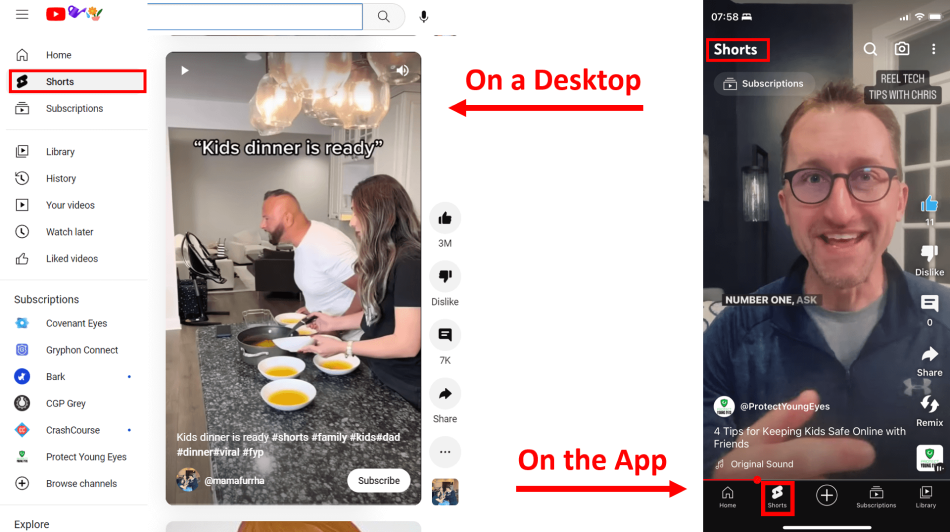
Can I Filter YouTube Shorts? Make them Cleaner?
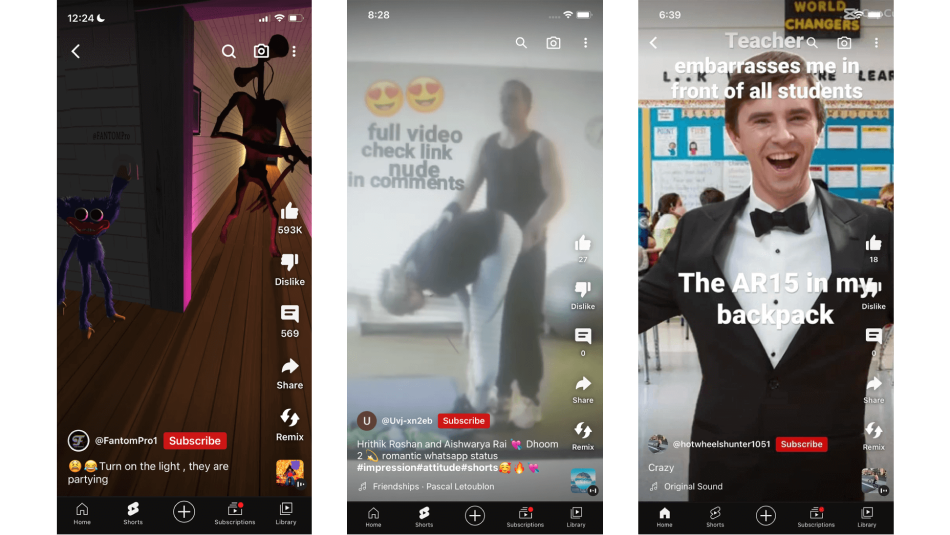
Here are some examples of the weird videos that can pop up. Creepy, inappropriate, or violent videos are some of the most common problems on YouTube. Thankfully, you can make them cleaner! By using a supervised account, you can help filter some of the bad and extreme content. Don’t worry we explain how to set up a supervised account below.
How do Subscriptions work on YouTube?
This tab shows you the latest videos from channels you’ve subscribed to:
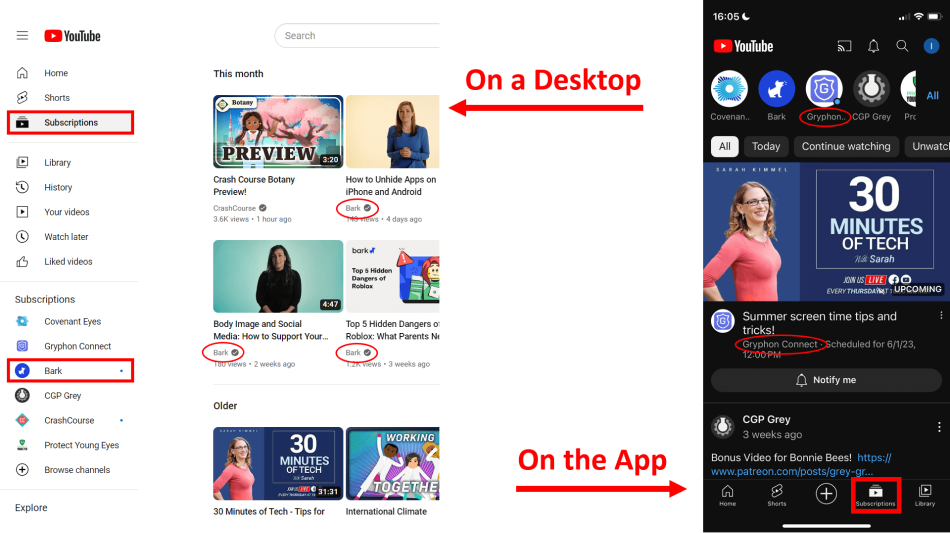
Subscribing to a YouTube channel simply means you are following that account and will receive a notification when they post. There’s no money involved, YouTube just uses the word “subscribe” instead of the more common “follow” that we see on most social media platforms.
- YouTube tip #6: tell your child that all subscriptions must be approved. Let them know you might check who they’re subscribed to from time to time.
Quick Note about Comments on Videos
YouTube Channels often encourage their viewers to comment on their videos. However, YouTube’s comment section is an area of special concern for younger users. In some cases, comments can be flooded by porn bots, cyberbullying, and allow viewers to talk with one another. And now, they are even testing comments on YouTube Music as well.
Here are ways to control comments on videos:
- If your child isn’t logged in to YouTube, comments are turned off, which is good.
- If your child is logged in, but has a Supervised account, comments are also turned off, which is good.
- The biggest risk related to comments, is if a child is using YouTube while logged in with an account that has an age 18+ birthday attached to his/her login (usually their Gmail account).
Don’t worry – everything related to creating a child’s account so that comments are controlled is explained below.
YouTube Library: This is where you Check and Watch History
This is where you can find your own uploaded videos, saved playlists, liked videos, and watch history. We especially want to check their watch history. You can see the Shorts and the normal videos they’ve watched.
YouTube tip #7: tap on “Manage all history” and enable their search history so it’s viewable:
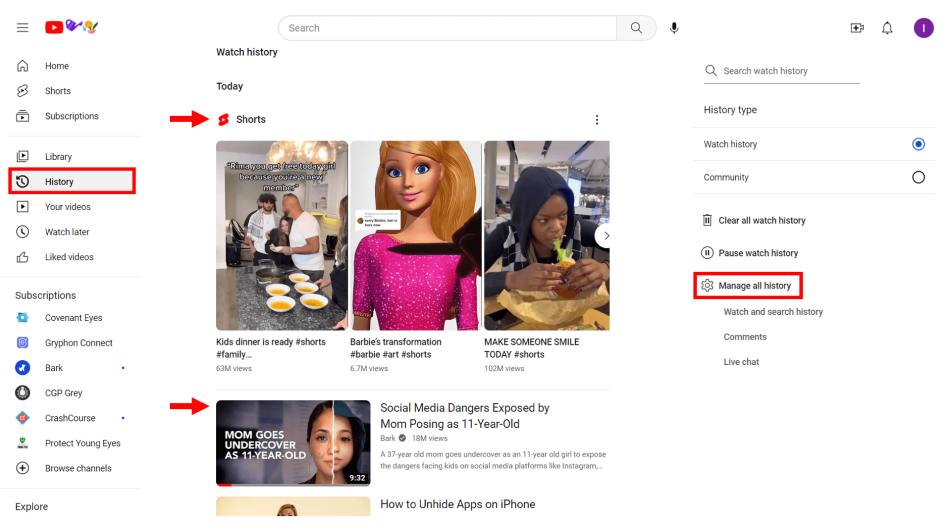
For those using the app, follow these instructions:
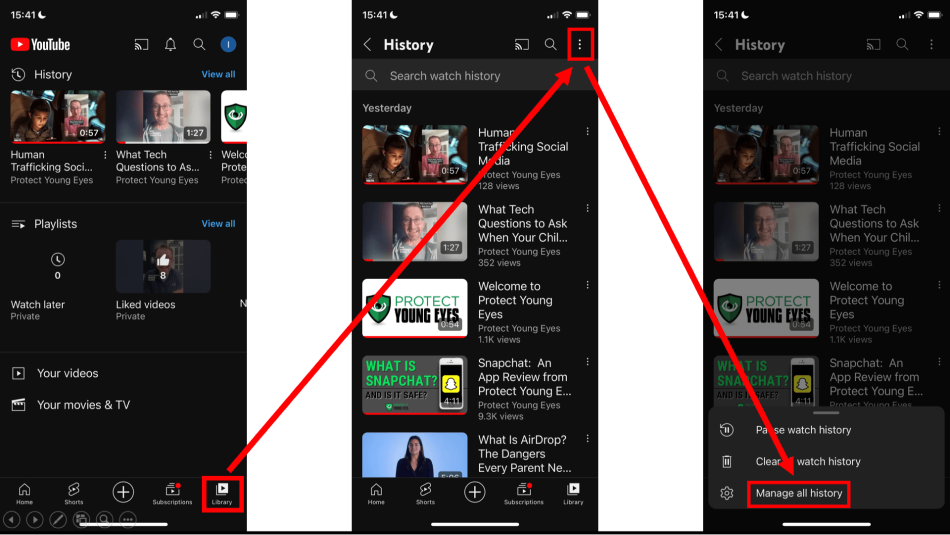
Select “Saving your watch history” and then, “Include your searches on YouTube”
This page will look the same for every device:

Big Problem: There is no way to stop your child from deleting their history. None of the settings available for YouTube allow you to do this…
- YouTube tip #8: For children still in elementary and middle school, be physically present when they watch YouTube.
- YouTube tip #9: Your relationship with your kid is stronger than any setting. Use it! Have open conversations with your child about the responsibilities of using YouTube and remind them that you trust them.
As you can see, there are plenty of helpful tips we can apply generically across YouTube. However, sometimes these all just look and feel so different based on our specific situation. So, we’re going over some common YouTube scenarios and will show you how to best navigate each one.
How to Make YouTube Safer for Specific Devices:
We’ll go through the technical solutions below. But under each of these devices, we could put the same relational comment: “Don’t forget to remind your child that if they see anything uncomfortable or explicit, they can land safely and softly with you.”
No child should probably use YouTube who hasn’t also already had a conversation with you about pornography. Even with controls and settings in place, we just don’t trust YouTube. Stuff can slip through. Now, on to some device scenarios!
Scenario #1: A Child is Using a Parent’s Phone to Watch YouTube.
- If your kid is using the YouTube app on your phone with your account (meaning YOU are logged in to YouTube), make sure that Restricted Mode is enabled. Follow the instructions below to manually enable Restricted Mode on the YouTube app:
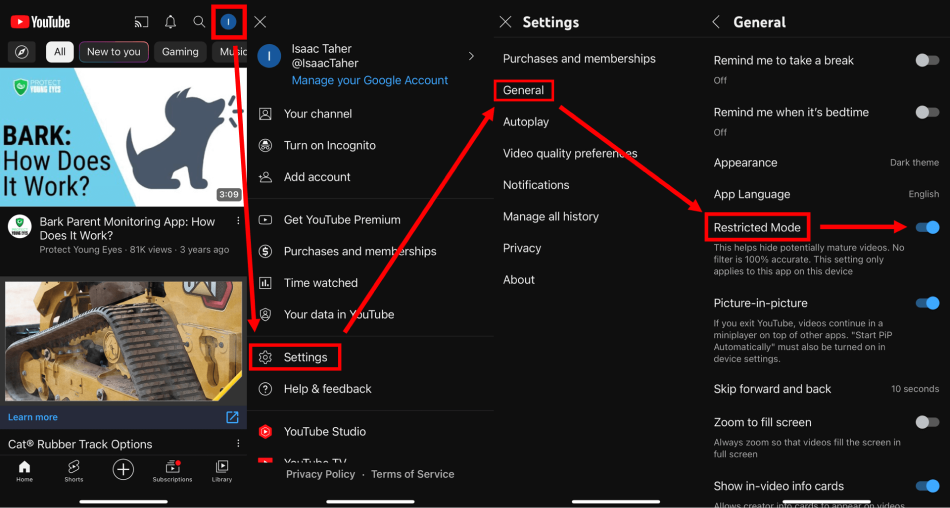
- Big Problem: Nothing stops your kid from signing out of your YouTube account and there’s no way to lock Restricted Mode while they’re in your account. So we recommend that if you’re only going to be lightly involved while they’re using your device to watch YouTube, then LOG OUT of the YouTube app. Let them either use YouTube logged in with their account or just stay logged out.
- They could also go to YouTube.com in Safari or another browser app (e.g., Chrome). If watching YouTube through a browser, and signed out, they will also have that Restricted Mode experience.
- YouTube tip #10: It’s extremely important that you use your child’s real birth year when setting up a Supervised account but for privacy reasons, you might choose not to use the same month and day. Chris (Founder) uses the same month and day, along with their year of birth (here’s a short Reel explaining our approach!). Many YouTube safety options are enabled by default when the user is aged 17 and under.
Scenario #2: A Child uses Another Tablet or Smartphone in your Home:
- Recommendation: create a Supervised Account for the child (follow that link and follow the steps). Remember: Supervised accounts are for minors. Parents – then download the Google Family Link app, which allows parents to manage how a child uses YouTube when they stick to that account.
- It’s in the Family Link app where parents can select between the three, Supervised levels of Explore (9+), Explore More (13+), and Most of YouTube.
- There are a lot of steps, so we've made an entire guide for setting up Family Link.
Here are the steps as it pertains to YouTube:
First, download the Family Link app or visit their web version.
Next, create a new child account in Family Link:
- Log in to Family Link with your Gmail account. Tap the icon in the top left corner and select “Add child.”
- If your child already has a Gmail account (maybe from school if they have a Chromebook, or if they already use a gmail account for YouTube), then select “Yes” and sign in with their account. If your child does not have a Gmail account, then select “No” and follow the steps.
- Select “Next.”
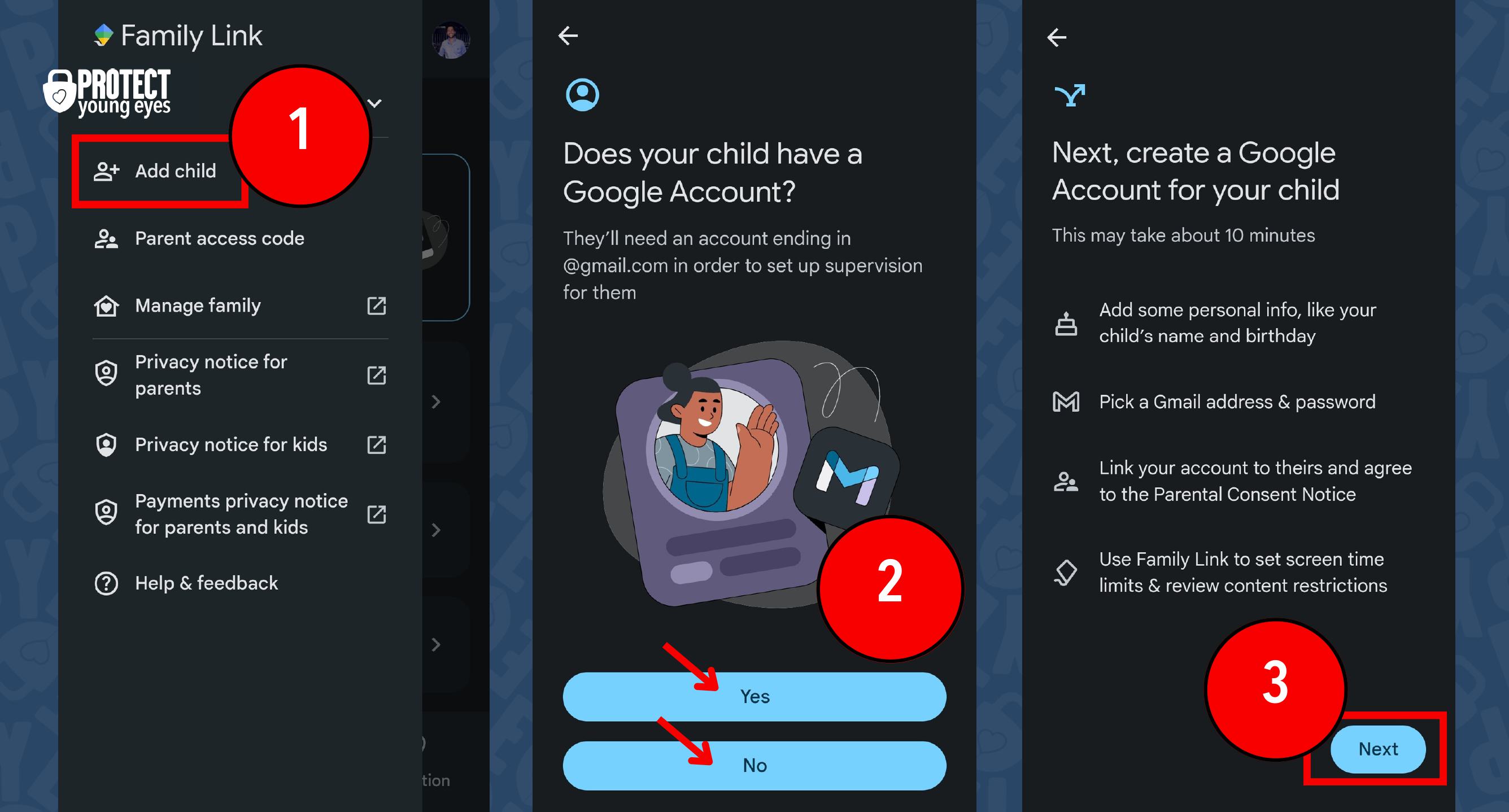
- Enter their first name (you don’t need to use their last name).
- Enter their birthday (just the month and year is enough, don’t use the exact day for privacy reasons).
- We recommend selecting “Turn off Web & App Activity.” Google doesn’t need to know what your child views.
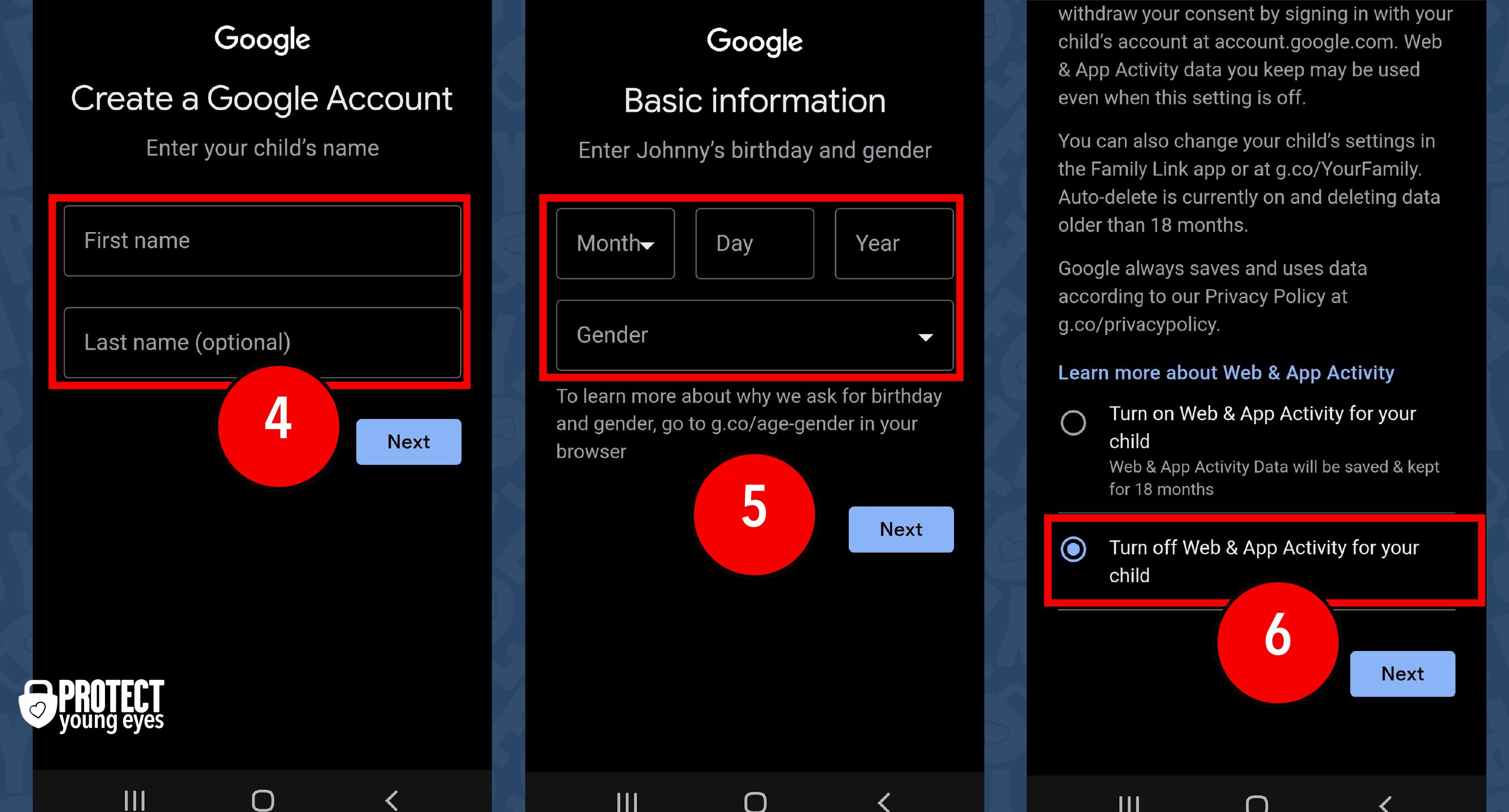
Now that your child is in Family Link, you can manage their account.
To make YouTube safer, start by selecting the "Controls" tab. Then (1) Select YouTube, then (2) choose either “YouTube” or “YouTube Kids” depending on which platform you want your child to use.
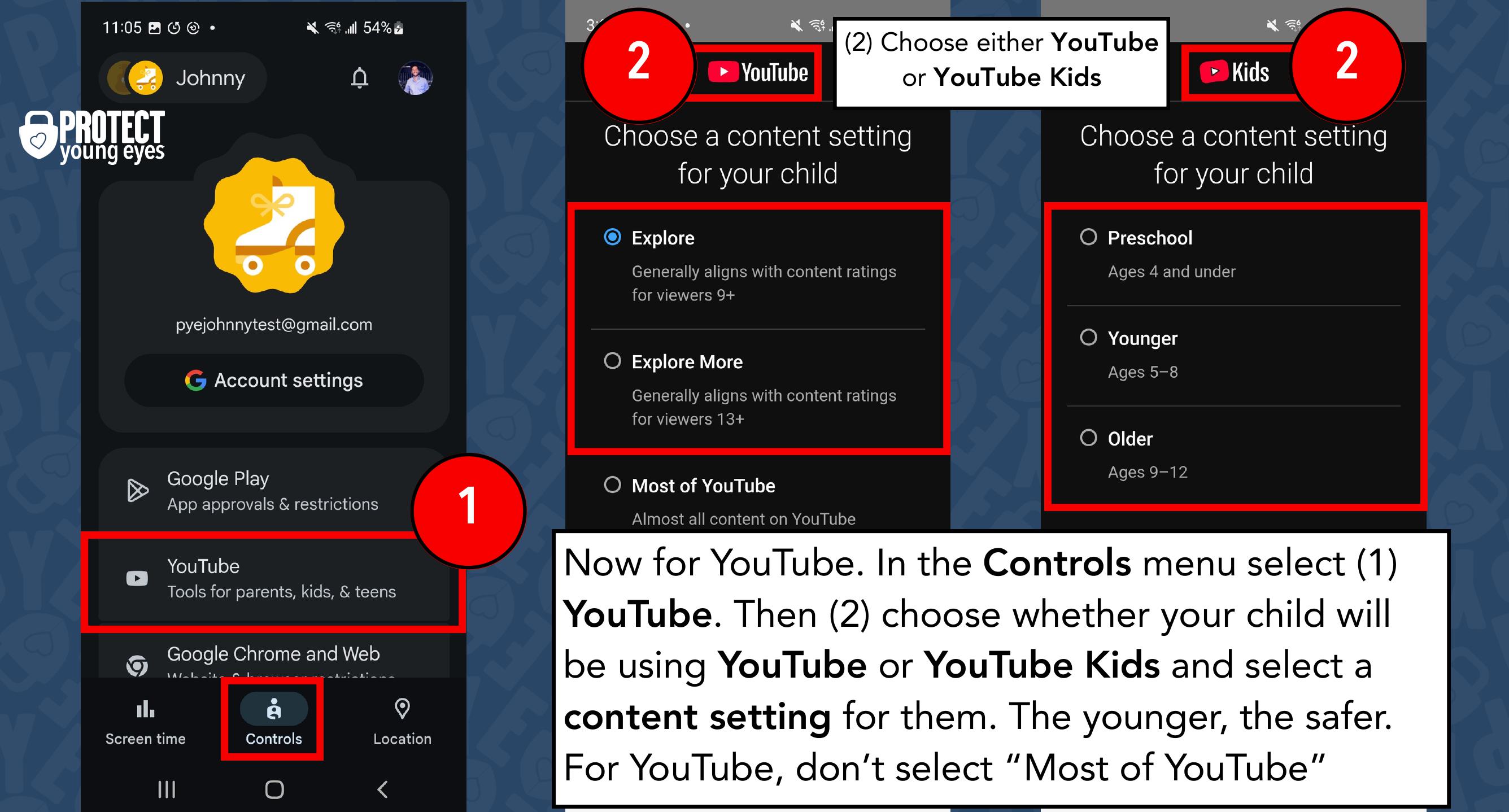
If you choose YouTube, you can now manage more settings. If you choose YouTube Kids, you can now manage one more setting. See the instructions below:
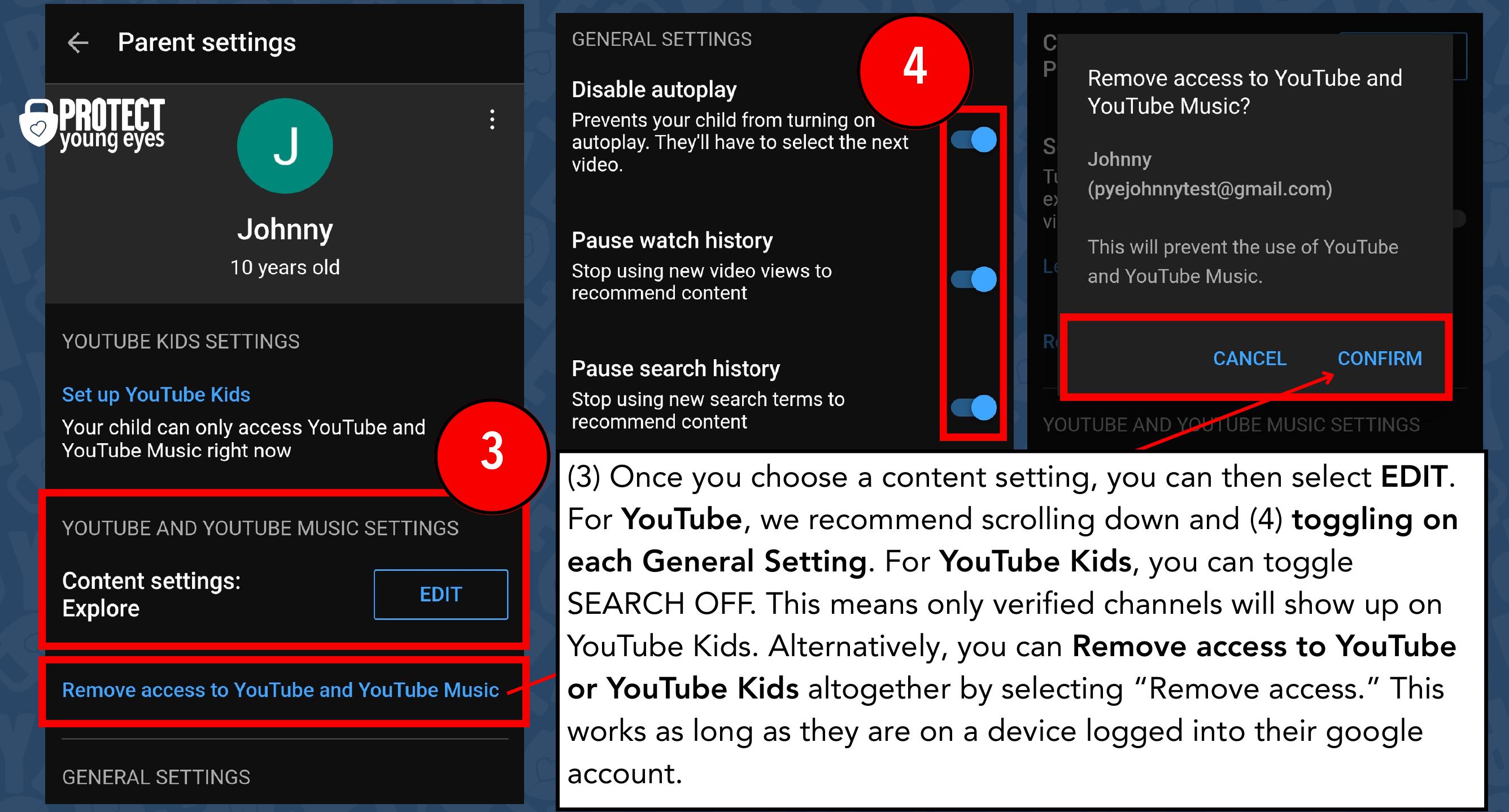
These controls should eliminate most of the problems you would face on YouTube. This works across all internet browsers and both the YouTube and YouTube Kids apps, as long as your child is signed into their Gmail account with these settings enabled. However, even Google points out that your kid might still see content you wouldn’t want them to.
- Problem #1 – they can always sign out – whether in Safari or the YouTube app, create a fake Gmail account as a fake “adult,” and log in. But please be involved enough to know if this is happening.
- Problem #2 – if using the YouTube app, they could just stay signed out, and although Restricted Mode would be in use, your child could use Incognito watching on YouTube and hide watch history.
- For a parent who has struggled with a child who misuses the YouTube app on Apple devices (iPads and iPhones), then sticks with locking down the App Store, removing the YouTube app, and “forcing” them to watch YouTube through the Safari browser with “Limit Adult Websites” checked in Screen Time (here’s where you find it: Settings -> Screen Time -> Content & Privacy Restrictions -> Content Restrictions -> Web Content -> Limit Adult Websites. Doing this locks in Safari search history. You can’t see individual videos they watched, but just saying, “I can see all of your history on Safari” is often enough to deter poor choices.
NOTE – “Chris, can I block YouTube altogether on my kid’s iPhone?” Yes, with some effort (there are so many iPhone backdoors). First, block the App Store (Apple), which you can do in Settings -> Screen Time -> Content & Privacy Restrictions. In Android, do this in the Family Link app. That means the YouTube App is blocked. But if you also want to prevent someone going to YouTube.com, then in Apple:
- Screen Time -> Content & Privacy Restrictions -> Content Restrictions -> enter passcode -> Web Content.
- Check “Limit Adult Websites.”
- **This is the key. Under “NEVER ALLOW” you have to type in the following web address: youtube.com
- Some parents have also noted that if App Limits or Downtime have been reached for the YouTube app, then a kid can also continue perusing YouTube videos through the iMessage widget (if you’re not sure what the “iMessage widget” is see the image below). This is true. Therefore, if this is being abused, you will need to remove the iMessage app from the “Always Allowed” list. Screen Time -> Always Allowed -> then remove it from Allowed Apps by tapping the red circle with the white minus sign.

- Scenario #3: How to Control YouTube when Everyone uses a Family Computer:
- This is for when a family has a shared computer that everyone is allowed to use.
- Recommendation: create a Supervised Account for the child (follow that link and follow the steps). Remember: Supervised accounts are for minors. Parents – then download the Google Family Link app, which allows parents to manage how a child uses YouTube when they stick to that account. It’s in the Family Link app where parents can select between the three, Supervised levels of Explore (9+), Explore More (13+), and Most of YouTube.
- Remove other accounts from each browser on the device. In other words, there might be three Gmail addresses logged into Chrome. Log out of all of them and then log in with the new Supervised account.
- Lock Restricted Mode on that browser! It will protect them even when they are signed out! Browsers on Computers/laptops are the ONE exception to the “oh, they can just sign out” comment we’ve used multiple times with smart devices. We’re unsure why Google doesn’t allow this “lock it in” ability on smartphones and tablets.
- Get a Gryphon router! Here’s our ultimate guide to routers where we highlight the features of a few and why we select Gryphon. It can lock in Restricted Mode for everything that connects to your home WiFi network.
- Bonus! Because Restricted Mode works on the browser level for the desktop version, you can sign in, lock it, sign out, and Restricted Mode will stay locked because you are using the same internet browser (Microsoft Edge, Safari, Firefox, etc.). This option offers great protection and is very easy to do:
- Select your account.
- Enable Restricted Mode if it’s not already on, then lock it.
- Next, you’ll have to use your password to verify it’s you locking Restricted Mode – kid proof!)
- Select your account again and sign out
- You have locked restricted Mode while being signed out! You can tell because the toggle is now gray and it says “Unlock” below.
- Repeat this process for every internet browser your kid has access to on this computer (Microsoft Edge, Safari, Firefox, etc).

- Scenario #4: YouTube Controls through a Chromebook
- Recommendation: create a Supervised Account for the child, then download the Family Link app and select the content level you want for YouTube.
- Follow the PYE Chromebook Set-up Guide. Because you’ll want to remove guest access and add new accounts to the Chromebook. This means you’ll need to be the administrator of the device (also explained in the PYE Chromebook Guide).
- Get a Gryphon router! Here’s our ultimate guide to routers where we highlight the features of a few and why we select Gryphon. It can lock in Restricted Mode for everything that connects to your home WiFi network.
- Scenario #5: YouTube Controls through a SmartTV
- Get a TV with some parental controls. We want SmartTVs that allow you to block apps from being downloaded to the TV unless a code is used. The Amazon Fire TV then goes one step more – even if an app is downloaded, like YouTube, it can be set up to prompt for that code before something is watched. We’ve created a Smart TV Set-up Guide for reference.
- What about with a Roku TV? You will still have to log in with a Gmail address to watch YouTube videos, which will either be a Supervised Account or an adult account and will follow the filter settings we’ve already discussed.
- Get a Gryphon router! Here’s our ultimate guide to routers where we highlight the features of a few and why we select Gryphon. It can lock in Restricted Mode for everything that connects to your home WiFi network.
- Note – I’ve had numerous parents express frustration with managing YouTube on their SmartTV. But also reluctant to put the hammer down. Delete the app from the TV. Get a TV that allows you to control what’s downloaded.
- Oh, and another tip that applies to all devices above – YouTube tip #11: We recommend you disable autoplay (here’s how from Google!). This way, your child has to manually select every video they watch, instead of YouTube just showing them more content.
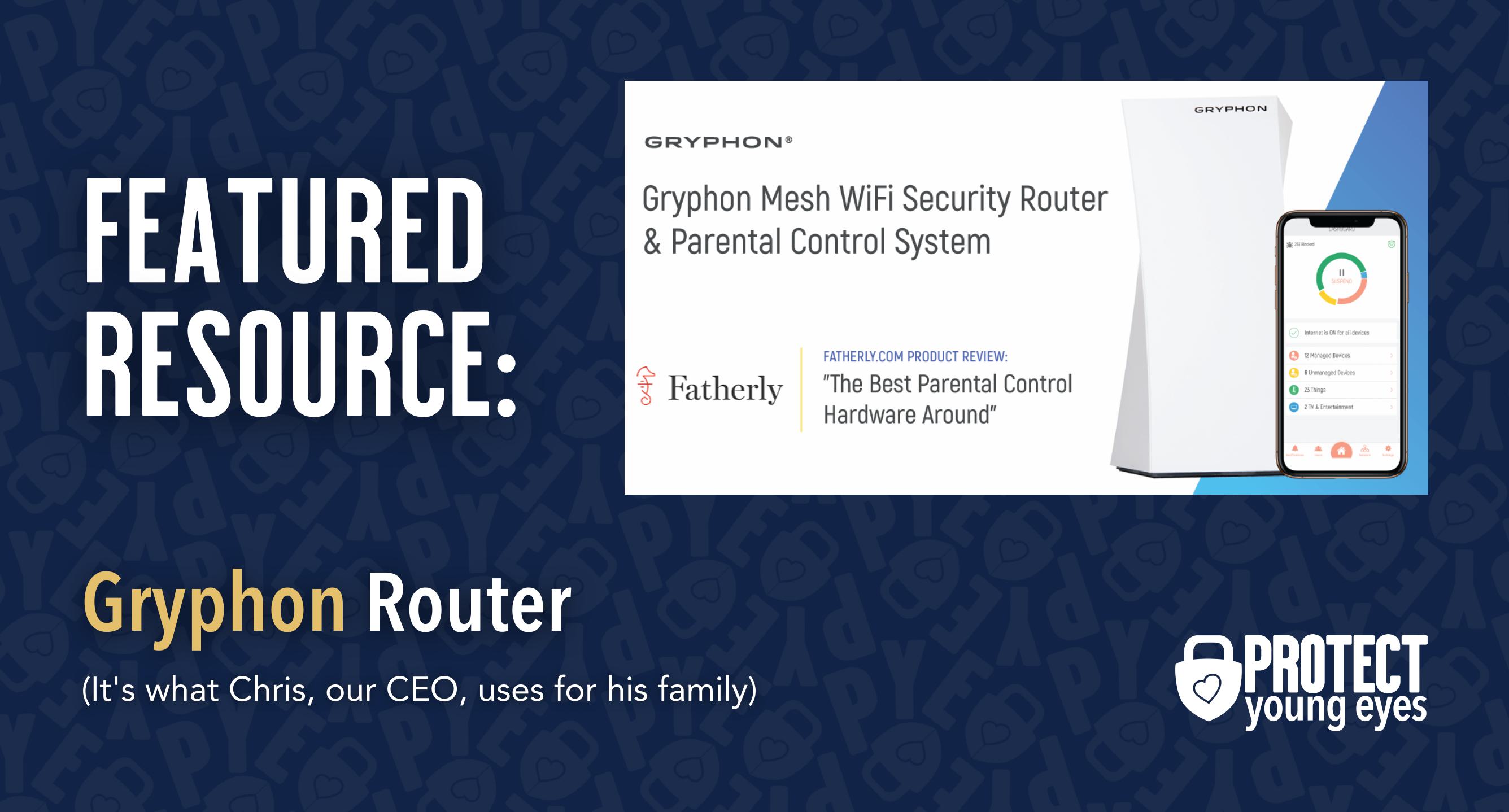
- If you decide you want a Gryphon, use: pyefriends15 at checkout for $15 off the Guardian or AX. If you decide that a Tower will work, we can offer them cheaper than anyone else for $109. Head over to our Ultimate Guide to Understanding Routers.
- Scenario #6: YouTube Controls through Gaming Consoles (e.g., Nintendo Switch, Xbox)
- Wow, isn’t it crazy that you can watch YouTube in so many places?
- Nintendo Switch – section under construction.
- Xbox – remember, this is a Microsoft product. Therefore, it’s controlled by Family Safety, which allows apps like YouTube on the Xbox to be controlled in the free version (here). If YouTube is accessed on the Xbox, then the same rules around Supervised Accounts, Restricted Mode, etc. will apply, depending on what kind of Gmail account they’re using to log into YouTube.
Bonus: Should My Kid Have Their Own YouTube Channel?
We get this question a lot! It can be okay for kids to have their own channel, but if they are making and posting videos, we have a few suggestions:
- Be in the Room (be with them when they record)
- Limit Recording Time (give them a time window)
- Post Privately (gives you control of who can watch their video)
- Disable Comments. Instructions below!
Creating a YouTube Channel
You can make a channel by clicking your account and selecting “Create a Channel.” When posting a video, you will be met with this screen as they introduce you to the YouTube Studio.
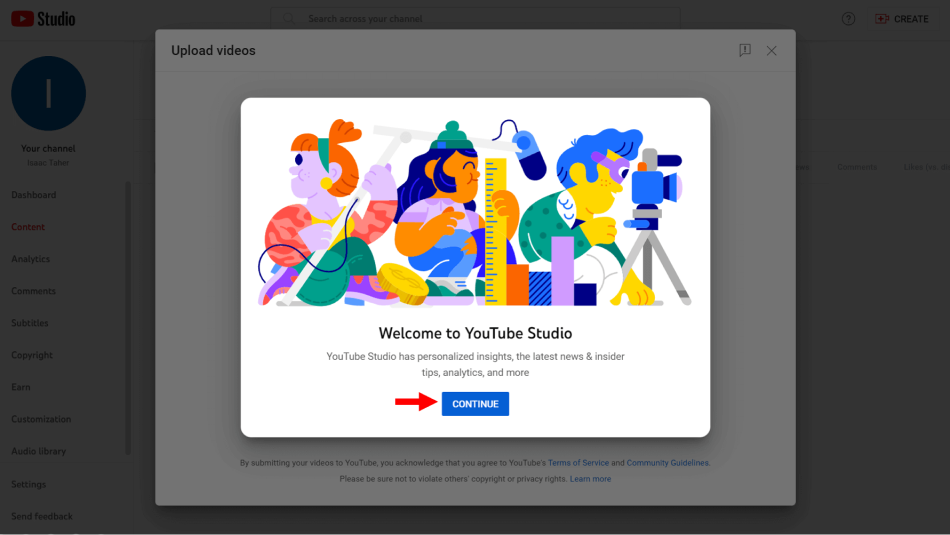
Next, select the video you wish to post.
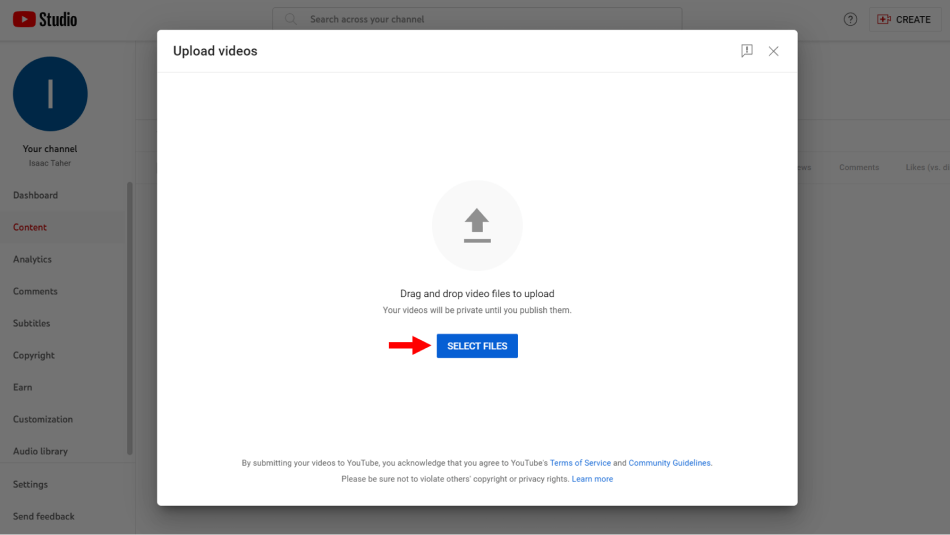
Put in a title and description if you want. Feel free to choose a thumbnail from the video, or use an image you have on your device.

There are some options for labeling your video so YouTube knows whether it’s designed for kids or not. Because we are only letting our kids post privately, this part doesn’t matter much.

Similar to the picture we showed earlier, please make sure you post videos that are Private or Unlisted. This way, you decide who can see their video. Copying the link will let you share your child’s wonderful creation with family and friends while keeping it hidden from strangers online.

Even amongst family or friends, people can say mean things. So, whether you post Private, Unlisted, or Public, please disable comments. Head to your YouTube Studio settings and follow our instructions.
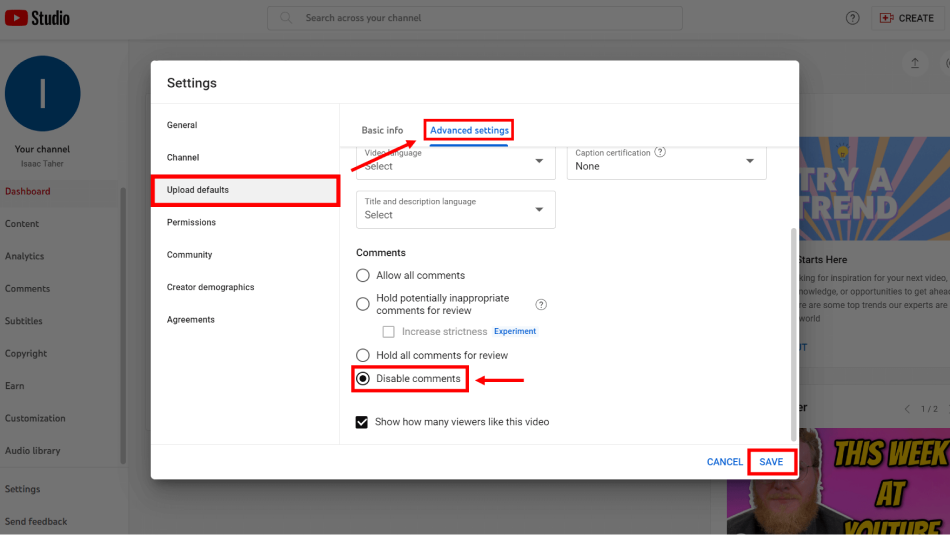
Important to note, that this is different from having the ability to comment on other videos, which is what Restricted Mode disables. This setting is specifically turning off the comment section for the video you are posting.
With these settings enabled, you’ve removed some of the risks related to your child spending extra time in such a powerful app. Remind them you trust them, and that it’s all the other people out there you don’t trust.
What about YouTube Kids?
So glad you asked! It’s better, but it’s not safe. Meaning, you can’t just give a kid an iPhone with YouTube Kids playing and trust everything he/she can see. We’ve written all about the correct YouTube Kids set-up in our app guide.
YouTube Controls Bottom Line:
The #1 best way to make YouTube a little safer for kids is to use YouTube while logged in with a Supervised Account. This allows you to use multiple content levels based on age, remove comments, and lock Restricted Mode (except for the app).
The #1 problem with YouTube is that on smart devices (iPhones, iPads, tablets), you can’t lock a Supervised Account into the YouTube account. This means a sneaky kid could log out of what mom set up and go with an account they created. This is a situation where the relational aspect of being a parent comes into play, offsetting a bit of the failure on the technical side. Persistent, curious questions.
A couple of the best technical offsets for this kind of behavior include:
- Using paid, third-party software like Covenant Eyes or Canopy, which can lock in Restricted Mode across the device. No matter what Gmail account is used.
- Get a router with parental controls that allow you to force your home network into Restricted Mode for everything on your WiFi!
Above all, remind your kids that you love and trust them. And when they see something weird, uncomfortable, scary, or inappropriate – remind them it’s not their fault, then practice “put it down” and “tell someone.”
What did we miss? Be sure to leave a comment and let us know.
You can do this!
What if I have more questions? How can I stay up to date?
Two actions you can take!
- Subscribe to our tech trends newsletter, the PYE Download. About every 3 weeks, we’ll share what’s new, what the PYE team is up to, and a message from Chris.
- Ask your questions in our private parent community called The Table! It’s not another Facebook group. No ads, no algorithms, no asterisks. Just honest, critical conversations and deep learning! For parents who want to “go slow” together. Become a member today!

A letter from our CEO
Read about our team’s commitment to provide everyone on our global platform with the technology that can help them move ahead.
Featured in Childhood 2.0
Honored to join Bark and other amazing advocates in this film.
World Economic Forum Presenter
Joined a coalition of global experts to present on social media's harms.
Testified before Congress
We shared our research and experience with the US Senate Judiciary Committee.




